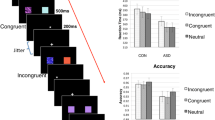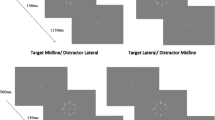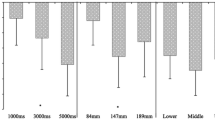Abstract
Visual-spatial orienting in high-functioning adults with autism and both chronological- and mental-age normal controls was examined. Three experiments were conducted in which stimuli were presented centrally and/or laterally (left or right of central fixation), and either detection or identification was required. The group with autism differed from normal controls by responding faster to central than to lateral stimuli, and by showing a left visual field advantage for stimulus detection only in the simplest condition (lateral presentations alone). Discussion focuses on the apparent abnormalities in disengaging/shifting attention, and on the coordination of attentional and motor systems in autism.
Similar content being viewed by others
References
American Psychiatric Association. (1987).Diagnostic and statistical manual of mental disorders (3rd ed., rev.). Washington, DC: Author.
Bashore, T. (1981). Vocal and manual reaction time estimates of interhemispheric transmission times.Psychological Bulletin, 89, 352–368.
Berlucchi, G., Heron, W., Hyman, R., Rizzolatti, G., & Umilta, C. (1971). Simple reaction times of ipsilateral and contralateral hand to lateralized visual stimuli.Brain, 94, 419–430.
Bryson, S. E., Landry, J. R., & Wainwright, A. (in press). Attention and executive function in autism: A critical review. In J. A. Burack & J. T. Enns (Eds.),Attention, development and psychopathohgy. New York: Guilford.
Bryson, S. E., Wainwright-Sharp, J. A., & Smith, I. M. (1990). Autism: A developmental spatial neglect syndrome? In J. Enns (Ed.),The development of attention: Research and theory (pp. 405–427). Amsterdam: Elsevier.
Burack, J. A. (1994). Selective attention deficits in persons with autism: Preliminary evidence of an inefficient attentional lens.Journal of Abnormal Psychology, 103, 535–543.
Casey, B. J., Gordon, C. T., Mannheim, G. B., & Rumsey, J. M. (1993). Dysfunctional attention in autistic savants.Journal of Clinical and Experimental Neuropsychology, 15, 933–946.
Cohen, G. (1972). Hemisphere differences in a letter classification task.Perception and Psychophysics, 11, 139–142.
Courchesne, E., Akshoomoff, N. A., & Ciesielski, K. T. (1990).Shifting attention abnormalities is autism: ERP and performance evidence. Poster presented at the International Neuropsychological Society Meeting, Orlando, FL.
Courchesne, E., Townsend, J., Akshoomoff, N. A., Yeung-Courchesne, R., Press, G., Murakami, J., Lincoln, A., James, H., Saitoh, O., Haas, R., & Schriebman, L. (1994). A new finding in autism: Impairment in shifting attention. In S. H. Broman & J. Grafman (Eds.),Atypical cognitive deficits in developmental disorders: Implications for brain function. Hillsdale, NJ: Erlbaum.
Dawson, G., & Lewy, A. (1989a). Arousal, attention, and the socioemotional impairments of individuals with autism. In G. Dawson (Ed.),Autism: Nature, diagnosis and treatment (pp. 49–74). New York: Guilford.
Dawson, G., & Lewy, A. (1989b). Reciprocal subcortical-cortical influences in autism. In G. Dawson (Ed.),Autism: Nature, diagnosis and treatment (pp. 144–173). New York: Guilford.
Dunn, L., & Dunn, L. (1981).Peabody Picture Vocabulary Test-Revised. Circle Pines, MN: American Guidance Service.
Fein, D., Humes, M., Kaplan, E., Lucci, D., & Waterhouse, L. (1984). The question of left-hemisphere dysfunction in infantile autism.Psychological Bulletin, 95, 258–281.
Heilman, K. M., & Van Den Abell, T. (1979). Right-hemispheric dominance for mediating cerebral activation.Neuropsychologia, 17, 315–321.
Hermelin, B., & O'Connor, N. (1967). Perceptual and motor discrimination in psychotic and normal children.Journal of Genetic Psychology, 110, 117–125.
Hermelin, B., & O'Connor, N. (1970).Psychological experiments with autistic children. Oxford, England: Pergamon.
Hobson, R. P. (1989). Beyond cognition: A theory of autism. In G. Dawson (Ed.),Autism: Nature, diagnosis and treatment (pp. 22–48). New York: Guilford.
Kinsbourne, M. (1987). Cerebral-brainstem relations in infantile autism. In E. Schopler & G. Mesibov (Eds.),Neurobiological issues in autism (pp. 107–125). New York: Plenum Press.
Lovaas, O. I., Schreibman, L., Koegal, R., & Rehm, R. (1971). Selective responding by autistic children to multiple sensory inputJournal of Abnormal Psychology, 77, 211–222.
Loveland, K., & Landry, S. (1986). Joint attention in autism and developmental language delay.Journal of Autism and Developmental Disorders, 16, 335–349.
Milner, A. D., Jeeves, M. A., Ratcliffe, P. J., & Cunnison, J. (1982). Interference effects of verbal and spatial tasks on simple visual reaction time.Neuropsychologia, 20, 591–595.
Mundy, P., & Sigman, M. (1989). The theoretical implications of joint-attention deficits in autism.Development and Psychopathology, 1, 173–183.
Mundy, P., Sigman, M., & Kasari, C. (1990). A longitudinal study of joint attention and language development in autistic children.Journal of Autism and Developmental Disorders, 20, 115–128.
Mundy, P., Sigman, M., Ungerer, J., & Sherman, T. (1986). Defining the social deficits in autism: The contribution of nonverbal communication measures.Journal of Child Psychology and Psychiatry, 27, 657–669.
Ozonoff, S., Pennington, B. F., & Rogers, S. J. (1991). Executive function deficits in high-functioning autistic individuals: Relationship to theory of mind.Journal of Child Psychology and Psychiatry, 32, 1081–1105.
Ozonoff, S., Rogers, S. J., & Pennington, B. F. (1991). Asperger's syndrome: Evidence of an empirical distinction from high-functioning autism.Journal of Child Psychology and Psychiatry, 32, 1107–1122.
Posner, M. I. (1988). Structures and functions of selective attention. In T. Boll & B. Bryant (Eds.),Clinical neuropsychology and brain function: Research, measurement and practice (pp. 169–202). Washington, DC: American Psychological Association.
Rave, J. C. (1969).Standard progressive matrices. London: Lewis.
Rincover, A., & Ducharme, J. M. (1987). Variables influencing stimulus overselectivity and “tunnel vision” in developmentally delayed children.American Journal of Mental Deficiency, 91, 422–430.
Rothbart, M. K., Posner, M. I., & Boylan, A. (1990). Regulatory mechanisms in infant development. In J. Enns (Ed.),The development of attention: Research and theory (pp. 47–66). Amsterdam: Elsevier.
Rumsey, J. M. (1985). Conceptual problem-solving in highly verbal, nonretarded autistic men.Journal of Autism and Developmental Disorders, 15, 23–36.
Shapiro, M. S., & Hynd, G. W. (1985). The development of functional lateralization in visual hemifield attention.Developmental Neuropsychology, 1, 67–80.
Smith, I. M., & Bryson, S. E. (1994). Imitation and action in autism: A critical review.Psychological Bulletin, 116, 259–273.
Tassinari, G., Aglioti, S., Chelazzi, L., Marzi, C. A., & Berlucchi, G. (1987). Distribution in the visual field of the costs of voluntarily allocated attention and of the inhibitory after-effects of covert orienting.Neuropsychologia, 25, 55–71.
Townsend, J., & Courchesne, E. (1994). Parietal damage and narrow “spotlight” spatial attention.Journal of Cognitive Neuroscience, 6, 220–232.
Wainwright-Sharp, J. A., & Bryson, S. E. (1993). Visual orienting deficits in high-functioning people with autism.Journal of Autism and Developmental Disorders, 23, 1–13.
Williams, D. (1992).Nobody, nowhere. Toronto, Canada: Doubleday.
World Health Organization. (1986).ICD-9: International classification of diseases and related health problems. Geneva: Author.
Author information
Authors and Affiliations
Additional information
We are grateful to the staff and residents of Woodview Manor, Hamilton, Ontario, and of Kerry's Place, Aurora, Ontario, for their participation. We thank Laura Westover and Donna Jenner for assisting in data collection and analyses. This research was supported by a Natural Science and Engineering Research Council grant awarded to S. E. Bryson. The two authors contributed equally to this work. Parts of this research were conducted in partial fulfillment of Ann Wainwright's Masters thesis and Laura Westover's and Donna Jenner's Honours theses.
Rights and permissions
About this article
Cite this article
Wainwright, J.A., Bryson, S.E. Visual-spatial orienting in autism. J Autism Dev Disord 26, 423–438 (1996). https://doi.org/10.1007/BF02172827
Issue Date:
DOI: https://doi.org/10.1007/BF02172827




